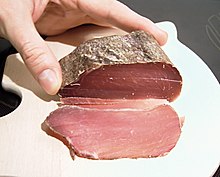Valais dried meat
|
|
|
| origin | Switzerland and Canton Valais |
| lean beef sticks | Corner piece, undercut, round mock, round nut and flat nut |
| pH of the fresh product | not over 5.9 |
| mild salting | rubbed with table salt |
| Air dry aging | 5 to 16 weeks (depending on size) |
| Weight loss compared to the fresh product | between 40 and 50 percent |
| Protein content | 40 g / 5 g fat per 100 g |
| Certification | GGA / IGP since October 14, 2002 |
Valais dried meat (short- dried meat , Valais German Trochufleisch , French Viande du séchée Valais or séchée Viande , Italian Carne secca del Vallese or Carne secca ) is a Swiss specialty exclusively of lean, salted and preserved by air drying maturing beef Stotzen that under no circumstances smoked or pickled and which are consumed raw. This is a trademark with a protected geographical indication (GGA, French indication geographique protégée, IGP ) of the canton of Valais .
Manufacturing
In contrast to Bündnerfleisch , Valais dried meat consists exclusively of the thighs of cows from Switzerland , is always processed in Valais, where it is mildly salted, and is generally not pressed, if at all only once. Depending on the region, air drying can be carried out in the Valais Alps from 800 to 1000 meters above sea level. During the long drying time of 5 to 16 weeks, the pieces of beef lose 40 to 50% of their fresh weight, whereby the typical flavors of Valais dried meat develop through the dehydration.
Marking and certification
Every manufacturer of Valais dried meat must prove that, on the one hand, the birth, fattening, slaughtering and cutting of the cattle took place exclusively in Switzerland and, on the other hand, that the relevant meat from corner pieces, slices, round nuts, flat nuts or round mockers (fish) was exclusively in the canton of Valais salted and dried. The relevant labeling must have the note "Protected geographical indication" or GGA / IGP and the corresponding logo.
history
In order to survive the cold season, the people of Valais - as elsewhere - were dependent on storing durable supplies. Thanks to the dry climate and the winds of the Swiss Rhone Valley as well as the ingenuity of the Valais, the methods of alpine salting in and alpine air-dry maturation emerged. The oldest surviving documents that describe the drying technique for meat products in Valais date back to the 14th century: the raw beef is rubbed with salt and air-dried in wooden stalls for at least six weeks. Dried meat is also mentioned in the German edition of the description of the country of Valais in Sebastian Munster's cosmography from 1544–1550.
Properties and tasting
Valais dried meat has a firm consistency and a purple, uniform color. With the Valais air-dry ripening, the meat retains its very own taste and receives a delicate bouquet. The taste and aroma are harmoniously matched to the salting, whereby herbs from the various Valais regions have been added to the table salt according to various traditional recipes, which contribute to the individual character of each individual Valais dried meat.
See also
Web links
- Everyday life in Valais - salting and drying on Walser-Museum.ch, as seen on March 7, 2017.
